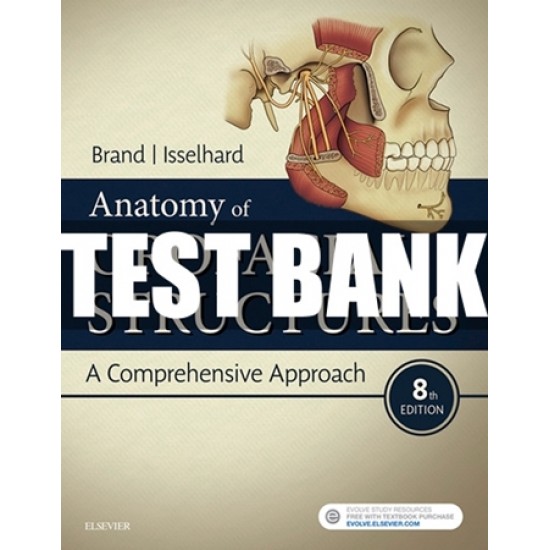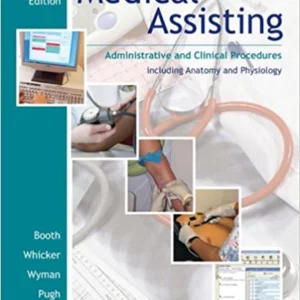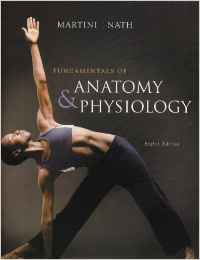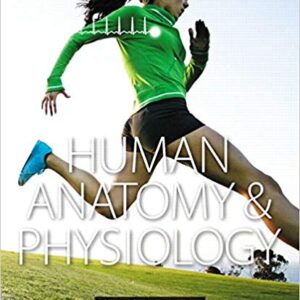Test Bank for Anatomy of Orofacial Structures 8th Edition By Brand
Chapter 01: Oral Cavity
MULTIPLE CHOICE
1. A diastema is a space between two teeth in the same arch. When this occurs between the
maxillary central incisors, it is often the result of a pronounced labial frenum.
a. Both statements are true.
b. The first statement is true; the second statement is false.
c. The first statement is false; the second statement is true.
d. Both statements are false.
ANS: A
A space, or lack of contact area, between any two teeth in the same arch is called a diastema.
When a diastema occurs between the maxillary central incisors, it is often the result of a
pronounced labial frenum extending to the crest of the alveolar ridge and possibly over the
ridge. This band of firm connective tissue causes the erupting incisors to be pushed aside
resulting in a diastema, or space. Correction of a diastema usually involves surgical removal,
or cutting, of the frenal tissue between teeth.
REF: p. 3
OBJ: To describe the boundaries and sub-boundaries of the oral cavity and the structures in each area
NAT: CDA: GC I.A.6. Identify basic oral anatomy and physiology, including but not limited to: oral
cavity. TOP: BLOOM: Remembering
2. Torus palatinus is seen on the
a. soft palate
b. hard palate
c. alveolar ridge
d. oral pharynx
ANS: B
Torus palatinus is excess bone growth and occurs in the midline of the hard palate. It may
grow to varying sizes and is generally only a problem when the construction of a maxillary
denture is necessary. In health, such bony protuberances, or excess bone growths, do not
occur on the soft palate, alveolar ridge, or oral pharynx.
REF: p. 5
OBJ: To define the terms vestibule, oral cavity proper, mucobuccal fold, frenum, alveolar mucosa,
gingiva, exostoses, torus palatinus, and torus mandibularis
NAT: CDA: GC I.A.2. Identify basic oral anatomy and physiology, including but not limited to:
bones. TOP: BLOOM: Remembering
3. Contraction of which muscle raises the tongue upward?
a. Mylohyoid
b. Palatopharyngeal
c. Palatoglossal
d. Levator glossal
ANS: A
Anatomy of Orofacial Structures 8th Edition Brand Test Bank
U S N TO
Contraction of the mylohyoid muscle raises the tongue. The palatopharyngeal muscle and the
palatoglossal muscle form the posterolateral borders of the oral cavity. There is not a muscle
by the name of levator glossal.
REF: p. 7
OBJ: To define the landmarks in the floor of the mouth and the hard and soft palate and the structures
that form them
NAT: CDA: GC I.A.4. Identify basic oral anatomy and physiology, including but not limited to:
muscles. TOP: BLOOM: Remembering
4. The oral vestibule is partially bordered by the lips and cheeks. The oral cavity proper extends
posteriorly to the soft palate.
a. Both statements are true.
b. The first statement is true; the second statement is false.
c. The first statement is false; the second statement is true.
d. Both statements are false.
ANS: B
The oral vestibule is the space or potential space that exists between the lips or cheeks and
teeth. In an edentulous person, the vestibule would extend between the lips or cheeks and the
alveolar ridges. The oral cavity proper is surrounded by teeth or alveolar ridges and extends
all the way back to the palatine tonsils. This includes the region from the floor of the mouth
upward to the hard and soft palates.
REF: p. 2
OBJ: To describe the boundaries and sub-boundaries of the oral cavity and the structures in each area
NAT: CDA: GC I.A.6. Identify basic oral anatomy and physiology, including but not limited to: oral
cavity. TOP: BLOOM: Remembering
5. Each of the following is true of the uvula EXCEPT one. Which one is the EXCEPTION?
a. It is located at the most posterior portion of the hard palate.
b. It is located at the midline.
c. It is a downwardly projecting muscle.
d. It is necessary for swallowing.
ANS: D
The uvula is a downwardly projecting muscular tissue located at the midline of the most
posterior portion of the hard palate. It is NOT necessary for swallowing.
REF: p. 6
OBJ: To define the landmarks in the floor of the mouth and the hard and soft palate and the structures
that form them
NAT: CDA: GC I.A.6. Identify basic oral anatomy and physiology, including but not limited to: oral
cavity. TOP: BLOOM: Remembering
6. The circumvallate papillae are located on the hard palate, buccal mucosa, and floor of the
mouth. The papillae found on the tongue are filiform, fungiform, vallate, foliate, and
incisive.
a. Both statements are true.
b. The first statement is true; the second statement is false.
c. The first statement is false; the second statement is true.
Anatomy of Orofacial Structures 8th Edition Brand Test Bank
U S N T O
d. Both statements are false.
ANS: D
All papillae listed in both statements are located on the tongue with the exception of the
incisive papilla, which is located on the hard palate. Note that the incisive papilla is a singular
structure, thus the different spelling. There are no papillae located on either the buccal mucosa
or the floor of the mouth.
REF: p. 7
OBJ: To define the landmarks in the floor of the mouth and the hard and soft palate and the structures
that form them
NAT: CDA: GC I.A.6. Identify basic oral anatomy and physiology, including but not limited to: oral
cavity. TOP: BLOOM: Remembering
7. Each of the following structures can readily be viewed when examining the oral cavity
EXCEPT one. Which one is the EXCEPTION?
a. Fovea palatinae
b. Tonsillar pillars
c. Laryngeal pharynx
d. Sublingual fold
ANS: C
The laryngeal pharynx is located below the oral pharynx and cannot be seen while examining
the oral cavity. The fovea palatinae, the tonsillar pillars, and the sublingual fold can be seen
when examining the oral cavity. Fovea palatinae are small depressions in mucosa on either
side of the posterior nasal spine indicating the junction of the hard and soft palate. Tonsillar
pillars are folds of tissue that partially surround the tonsils. The sublingual fold extends
backward on either side of thNe floRorIof thGe mBo.utCh anMd is situated just superior to the
submandibular gland.
REF: p. 2 | pp. 6-7
OBJ: To describe the boundaries and sub-boundaries of the oral cavity and the structures in each area
NAT: CDA: GC I.A.6. Identify basic oral anatomy and physiology, including but not limited to: oral
cavity. TOP: BLOOM: Remembering
8. Each of the following structures is located within the hard palate EXCEPT one. Which one is
the EXCEPTION?
a. Incisive papilla
b. Rugae
c. Greater palatine foramina
d. The anterior and posterior pillars
ANS: D
The anterior and posterior pillars are located posterior to the soft palate. The posterior pillar is
also called the palatopharyngeal arch or fold. The anterior pillar is also called the
palatoglossal arch or fold. The tonsils lie between the anterior and posterior pillars.
The incisive papilla and rugae are located on the anterior portion of the hard palate. The
greater palatine foramina are located in the posterior portions of the hard palate lingual to the
second and third maxillary molars.
REF: pp. 5-6
Anatomy of Orofacial Structures 8th Edition Brand Test Bank
OBJ: To define the landmarks in the floor of the mouth and the hard and soft palate and the structures
that form them
NAT: CDA: GC I.A.6. Identify basic oral anatomy and physiology, including but not limited to: oral
cavity. TOP: BLOOM: Remembering
9. The small bony growths that commonly occur on the buccal cortical plate of the maxillae and
the mandible are called
a. torus palatinus
b. mandibular tori
c. exostoses
d. maxillary tuberosity
ANS: C
Exostoses, small bony growths that occur on the buccal cortical plate on the mandible and the
maxillae, are seen in a large portion of the population. They are normally inconsequential
unless they become tender or a denture is needed. Exostoses occur more frequently on the
mandible than on the maxillae.
Torus palatinus are excess bony growths that commonly occur in the midline of the palate.
Mandibular tori are bony swellings that frequently occur on the lingual surface of the
mandible at the canine area. The maxillary tuberosity is a rounded bony protrusion in the area
of the third molar.
REF: p. 4
OBJ: To define the terms vestibule, oral cavity proper, mucobuccal fold, frenum, alveolar mucosa,
gingiva, exostoses, torus palatinus, and torus mandibularis
NAT: CDA: GC I.A.2. Identify basic oral anatomy and physiology, including but not limited to:
bones. TOP: BLOOM: Remembering
10. Which structure is the MOST vascular in appearance?
a. Mucogingival junction
b. Alveolar mucosa
c. Labial frenum
d. Gingiva
ANS: B
The alveolar mucosa, a thin layer of loosely attached and movable tissue, covers a highly
vascular area. The presence of blood vessels immediately under this relatively thin mucosa is
responsible for the general reddish color. By contrast, the mucogingival junction that divides
the attached gingiva from the alveolar mucosa appears pinker in color. The gingiva and
labial frenum also appear pink in color.
REF: p. 2
OBJ: To define the terms vestibule, oral cavity proper, mucobuccal fold, frenum, alveolar mucosa,
gingiva, exostoses, torus palatinus, and torus mandibularis
NAT: CDA: GC I.A.6. Identify basic oral anatomy and physiology, including but not limited to: oral
cavity. TOP: BLOOM: Remembering




